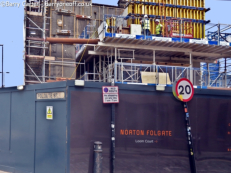





Docklands and the Thames,
Victoria Park to Paternoster
Square. Take a nostalgic
trip back to the East End in
the 1950’s or a stroll around
the Square Mile of the City
of London. It’s all here at
barryoneoff.co.uk
Copyright 2002 - 2024 ©Barry Carter. All rights reserved
SPITALFIELDS The Upmarket Market
Spitalfields
Up until 1991 the main activity of the area concentrated on the wholesale fruit and vegetable market. This market has now moved to Leyton and is trading as the New Spitalfields Market. The site it left behind is now a modern type "trendy" market selling all sorts of goods and street food but retaining the Spitalfields Market name. It varies from day to day, but the busiest day is Sunday. There are some nice historic and pricey pubs in the area too. These include The Ten Bells, The Gun and the tiny Pride of Spitalfields. Another pub,The Water Poet, unfortunately closed in March 2019 for redevelopment on Folgate Street. The Gun is still there but looking very different. The other main attraction to the area is Christ Church Spitalfields, which was allowed to become run down over the years but has now been brought back to it's former glory. There is a very nice cafe inside. Much of the old market has been redeveloped but the Eastern end has been saved as a popular food and general market which has been at the centre of a revival in the area. It has been for the past few years the "in" place for the Trendies and "artistic" types for want of a better phrase. Don't get me wrong, I love them and the fresh feel they bring to the areas they settle in. They have certainly saved some pubs and markets of the East End. Unfortunately they pump up the prices and don't mind paying them. The East end of the Market has protected Horner buildings, and so could not be redeveloped.Christchurch
In 1960 Christ Church was almost a derelict shell. Services could not be held there as the roof was unsafe. The building was under threat of demolition until the Hawksmoor Committee managed to save the empty building from the plans proposed by the then Bishop of Stepney, Trevor Huddleston. As far as I know, the roof was rebuilt with funds raised by the sale of the bombed out Church of St John's in Smith Square. In 1976 the Friends of Christ Church Spitalfields was formed to restore the church and bring the Grade I Listed Building back into use. Services resumed in 1987. The west end was repaired and cleaned in 1986, when the aisle windows were replaced by exact replicas of the originals. The 202 ft spire renovated in 1997. The south side was renovated in 1999 revealing the brilliant white stone and the detail hidden by years of pollution and neglect. The steps were rebuilt at this time also, and the iron gates and railings removed for the war effort were also replaced. The renovation and restoration work continued until 2004. The church is now as when first built. There is a large cafe in the crypt.Spitalfields Sculpture
"I Goat" won the Spitalfields Sculpture Prize in 2010 and was subsequently unveiled in 2011. The goat stands on packing crates, supposed to be inspired by the areas social history and a symbol of migration over the years. There are other very good sculptures scattered around the area too. In 2020 a herd of Elephants invaded the market, positioned all over. I don't know how long they are there for but they are still around in 2022. More Elephant photos >>History destroyed by
Developers
The name Spitalfields comes from “hospital fields”. It originated from The Priory of Canons and Hospital for poor brethren of the Order of St Austin which was founded in 1197. It later became The New Hospital of our Lady without Bishopsgate. The Old Spitalfields Market is now a covered market. It is just outside the Square Mile that makes up the City of London. The buildings in use today were built in 1887 to service a wholesale market, owned by the Corporation of London. This was on the site of a public market, founded in 1682 by Charles II. Charles' Spitalfields Market was founded to feed the growing population of this part of London. It was originally just fields. The buildings have undergone modernisation since the wholesale market moved out and the streets around the area are gradually being devoured by developers and replaced with shiny new metal and glass modules. In the 1990's there was a dispute between the Corporation of London and the Spitalfields residents about redevelopment of the Western end. The residents lost and Norman Foster now has an office block designed by him dominating the area. In all, about two thirds of the historic market were demolished by the developers. There have been many more building works going on in the area and there were also many disputes about one of them, the redevelopment of the Fruit and Wool Exchange. Boris Johnson, in 2012 as Mayor of London, gave his consent to the plans and the new building was completed in 2018. In 2020 when I visited the site again only the frontage of the old building has been preserved. Spitalfields photo albums >>



























